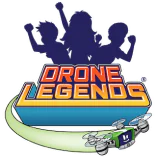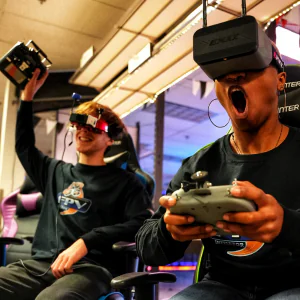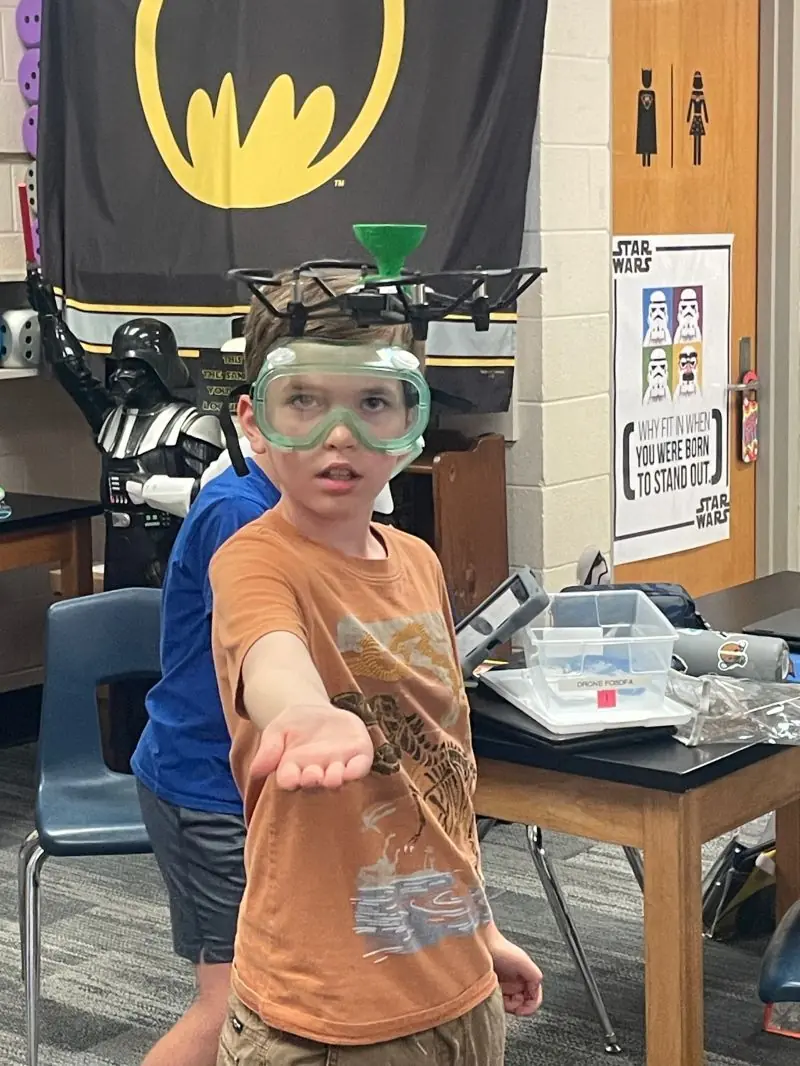Seems like these days, educators are in a race to maximize the “hands-on” element of STEAM learning, and I love that. The truth is, kinesthetic learners and non-traditional learners have often been at a disadvantage. When the vast majority of academic ideas are conveyed through print or lecture, it can be hard even for very traditional learners to stick with it. Students need a break from the “sit and listen” approach (although that has its place) and the many STEM labs, STEM magnet schools, and STEM classroom experiences are filling the gap in a wonderful way.
Of course, here at Drone Legends, we use drones in the classroom as an ideal way to get kids up and about, letting them operate in the real-world, troubleshoot, coordinate, and get instant feedback. It’s the best. And here are 10 ways to use drones in the classroom (that you can do with our Drone Legends curriculum, or adapt to your own context). Enjoy!
1. STEM Challenges
Think of your favorite STEM challenge and add a drone to tech it out! Do you love the egg-drop challenge? Lift and launch the egg using a drone, it’s safer than a ladder and a lot more fun. Love the build- a-bridge challenge? Land a drone on the bridge to test it, or flip objects onto the bridge.
You can also test the strength of the bridge in windy conditions using the force of the air coming from the propellers. Love the tower challenge? See which towers can withstand the force of a drone collision. Build an elevated landing pad for a drone, flip mints from a drone into a bottle of diet cola, or flip two objects of different weights to test acceleration due to gravity. There are a million untapped STEM uses for drones – tap a few for yourself.
2. Drone Racing
Drone racing is becoming a hot ticket item! While racing is fun it can sometimes lead to toxic competition among peers. One way to keep the racing collaborative is to have students race against the clock rather than against each other. Give students a set time by which all teams should fly through a given race course. Working together, the last team will learn from the mistakes of the first team and they will collaborate to overcome challenges, obstacles, and failures to ultimately beat the clock, not each other.
3. Obstacle Courses
A central part to drone racing is the obstacle course. As drone pilots gain advanced flying skills, obstacle courses need to up the difficulty level. Discuss as a class some of the most challenging flight skills and make a list of those you want the students to include in an obstacle course. Then task students with building the most challenging obstacle course they can.
Have teams race the courses and then rate them on their level of difficulty. After the races, discuss the pros and cons of each course and allow students time to redesign and rebuild their courses. Hold a grand prix drone race with each team flying each course and then combining all of their flight times. The lowest score wins!
4. Career-Based Flight Paths
Challenge your students to choose a STEM career in which a real-world scenario can be created that requires the use of a drone to complete a task. Require the students to identify the job within the career path and then describe the tasks that can be performed with a drone.
Finally, have them write up the real-world scenario as a mission plan and draw and label the flight path for the drone, explaining the tasks that need to be completed and how the drone pilot will know if they’ve been successful.
Bonus: include this with designing and building obstacle courses for a complete drone experience!
5. Hands-On Projects
Students love to feel needed. Engage in a drone-based hands-on service project for your school, neighborhood, community, or city. Use a drone to detect litter along a roadway that needs to be collected, to calculate the total shaded area of a park, to inspect rain gutters for the elderly, or to reseed an abandoned lot or school playground.
Host a drone demonstration at a retirement center, give a drone performance for a younger grade, or deliver notes from the office to a classroom for a little classroom excitement.
6. Drones and Art
Dones have been used in videography, rock concerts, dance performances, music festivals, and large light shows for inaugurations or olympic celebrations. Research the use of drones in entertainment and find a new way to employ a drone in creating art. Perform your art pieces for each other at the end of the project.
7. Make a Video With a Classroom Drone
Choose a social, political, or environmental issue that affects the students in your school and then create an opinion piece about your topic. Use the classroom drone to capture video footage and photographs and use them to produce a video about the causes and possible solutions. Share the video with your school during morning announcements or at an assembly or via email. Invite feedback on a social media platform or other method.
8. Learn to Fly Drones
Spend some time researching drone flight skills required for different drone-based careers. Watch videos and read about the skills and then learn how to do them. Identify, learn, and practice three new skills and then perform those skills for your team or class.
9. Code Drones
The Tello drone can be coded to fly autonomously using drone blocks. Choose a drone project that you have worked on during the year (STEM challenge, drone race, obstacle course, flight plan, service project, or art piece) and use Drone Blocks, or any other coding app, to create a code for your drone to complete the project autonomously. Be sure to measure the distances it has to travel, the degree for each angle it turns, the height of each throttle up or down, and the average distances an object can flip. Use these measurements to create and test the coded autonomous flight.
10. Use a Quality STEM Curriculum for Drones in the Classroom
There are a million different ways to use drones in a classroom. If you feel overwhelmed by the many ideas, options, and opportunities, look for a STEM-based drone curriculum that delivers all of this! Look for a curriculum that is aligned to state learning standards, addresses the engineering design process, and helps engage students in hands-on learning.
The program should be flexible enough to accommodate a varying number of students and a varying length of time. It should provide all of the materials you need for each STEM application and career-base connection. It should also present a set of learning activities that teach fundamental flying skills as well as coding skills.
If you would like to know more about just such a curriculum, give us a shout!




